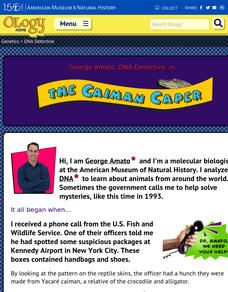Museum of Science
Fingerprints
Capture your unique print. Individuals ink a finger and create a print on a deflated balloon. By blowing up the balloon, pupils get a magnified view of their unique print. They see if they can identify any loops, whorls, and arches in...
Curated OER
Human Fingerprints: No Two the Same
Sixth graders explore scientific observations by analyzing a group of data. In this fingerprint identification lesson, 6th graders identify the reasoning behind fingerprinting and create their own ink fingerprints. Students discuss the...
Curated OER
Who Done It?
Pick and choose which activities to include in this crime scene investigation. Junior detectives can examine fingerprints, DNA, blood samples, or bone structure. The plan suggests you have teams solve a mystery, but it does not...
Curated OER
Fingerprinting
Students list and describe the three types of fingerprint patterns. They list and describe three layers of fingerprints that can be made. They explain why we leave fingerprints.
Curated OER
Fingerprinting
In this fingerprinting worksheet, students write short answers to 16 questions about the principles of fingerprinting. They explain how this method is used to identify criminals.
Curated OER
Fabulous Forensic Fingerprints
Learners observe their fingerprints and notice how all human bodies are different. In this fingerprints lesson plan, students see the loops, whorls, and arches that make everyone's fingerprints different, and make a class graph for which...
Teach Engineering
DNA Forensics and Color Pigments
Use food coloring in electrophoresis. The last segment in a four-part series mimics DNA fingerprinting by using chromatography. Teams conduct chromatography on food coloring to find colors that use similar pigmentation in their makeup.
Curated OER
DNA Fingerprinting: You Be the Judge!
Students explore DNA fingerprinting. Students discover how DNA fingerprinting is done and judge the validity. They evaluate the use of certain prints in courts and address the ethics of establishing a national database of fingerprpints.
Curated OER
"Who Done It?" Analysis of Molecular Fingerprints Left At the Scene of the Crime
Students examine different types of DNA fragments. They record and analyze their results. They determine who is the criminal in the story.
Manitoba Education and Early Childhood Learning
Forensic Sciences: A Crime Scene Investigation Unit
Mr. Bergman has been murdered and we need you to solve the crime! The cross-curricular unit covers 11 different types of forensic science and includes 17 activities. Scholars perform blood type analysis, blood spatter analysis,...
Curated OER
Is Your Spot Hot?
Eighth graders explore global warming. In this Earth Science lesson plan, 8th graders will look for Harbingers and fingerprints for different areas. The students will identify an area at risk and they will then create a...
Curated OER
Fingerprint Identification 1
In this forensic science worksheet, students classify 8 fingerprint marks according to the correct type. They also identify the unique ridges on 2 prints.
Curated OER
Fingerprint Identification 4
In this forensic science worksheet, students identify 16 fingerprints according to its type. They classify them as either whorl, loop or arch.
New York City Department of Education
Grade 9-10 Literacy in Science: Using DNA to Solve a Crime
Scholars become detectives and use science to solve a crime! A complete unit introduces DNA and includes hands-on activities that have learners model DNA and extract it from different food types. A culminating activity challenges...
American Museum of Natural History
DNA Detective
Match up the DNA code. Pupils read the website from the American Museum of Natural History about how DNA can determine whether a skin is from a particular type of reptile. Using the same technique, learners match up products with the...
Curated OER
Classroom Identity
Learners explore fingerprints. In this finger prints lesson, students investigate how to classify fingerprints. Learners study large pictures of fingerprints and circle the patterns they know how to identify. Students then take their own...
Curated OER
Uniqueness in All
Students share verbally at least one thing that makes them unique, observe, compare and record their fingerprints, classify which of the basic fingerprints resemble their own and share their findings.
Curated OER
Crime School Investigations
Students solve a mystery at their school. In this classifying lesson, students find suspects who committed the crime. Students categorize them into race, sex, and fingerprint type. Students show their results in graphs.
Curated OER
Classification
In this classification worksheet, students observe the fingerprints provided. Students decide upon a classification system to use to categorize the given fingerprints.
Curated OER
DNA Fingerprinting: You Be the Judge!
Students use their knowledge of DNA fingerprinting to evaluate the use fingerprints in courts, and will address the ethics of establishing a national database of fingerprints.
Curated OER
Fingerprint Bug Math
Students make flash cards. In this counting lesson, students use their fingerprint to make bug pictures. Students use the pictures to create math flash cards and use them to play counting games.
Curated OER
DNA Fingerprinting with Gel Electrophoresis
Learners use DNA fingerprinting to demonstrate the concept that DNA fingerprinting can be used to identify individuals and solve problems. They use gel electrophoresis to analyze the DNA of a suspected criminal to prove innocence or guilt.
Curated OER
Fingerprint Card
Students create their own identification card to be used in case of emergencies. In this art lesson, students print important information about themselves on a notecard and make a print of one of their fingers by coloring the...
Center for Technology in Teaching and Learning
CSI: The Experience - Family Forensics
Forensic scientists depend on their observation skills to analyze evidence down to the molecular level. Middle and high schoolers practice making observations and predictions with a series of crime scene activities, which includes a...























